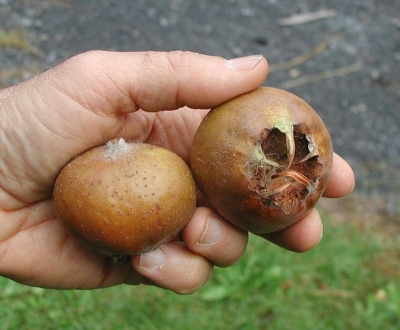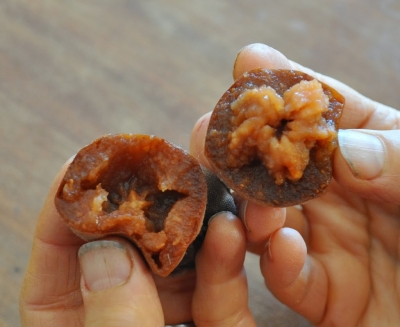Today’s fruit du jour is medlar (Mespilus germanica), one of the most-disgusting-looking fruits you could imagine. Don’t stop reading! Medlar was a popular fruit in the Middle Ages, and with good reason. Charlemagne was so taken by this fruit that he decreed that it be planted in every town he conquered. Medlar needs some contemporary pr.
Let’s get those bad looks out of the way. Picture a small apple with a rough, russeted skin and the calyx end — the end opposite the stem — flared open. Not very pretty, eh? That homely appearance gave rise to
some not-so-complimentary nicknames. “Open-arse” fruit, for example, by Chaucer. Or, from Shakespeare, more discretely, “open-etcetera.”
Ugliness, for medlars, is not just skin deep. When harvested, which was a few weeks ago here, the fruits are white and rock hard within, and not ready for eating. The fruit must be bletted, or ripened, a couple of weeks or more. I blet my medlars by setting them on the cool, north windowsill facing my kitchen sink. With the woodstove at full tilt, the air at the windowsill might still be too dry for best bletting, so I also have a few fruits bletting beneath a small bell jar in another cool part of the kitchen. A wrinkling, dark skin tells me that bletting is complete. At this point the flesh has experienced a dramatic transformation — to brown mush.
I put all that ugliness behind me and taste that brown mush. Delicious! Something like very rich applesauce with hints of wine. I’ve only eaten them straight
up. They allegedly also cook up into delicious tarts, jellies, “fools,” and the like. Here’s a simple recipe for a tart, dating back to 1660, from Robert May’s The Accomplisht Cook: “Take medlars that are rotten, strain them, and set them on a chaffing dish of coals, season them with sugar, cinamon and ginger, put some yolks of eggs to them, let it boil a little, and lay it in a cut tart; being baked scrape on sugar.”
(For a once popular fruit, medlar has had its share of pejoratives. “Rotten,” in the above recipe, means bletted. But many fruits, including European pears and avocados, need to be harvested unripe to ripen off the plant. Admittedly, few are brown mush when ready to eat.)
————————————————————–
So much for medlar’s bad looks and good flavor. Let’s take a good look at the plant itself.
Those ugly fruits ripen on a very attractive, small tree that never reaches more than about eight feet high or a spread of equal width. It’s a year ‘round beauty, even now, leafless, with its craggy branches and light brown bark. In spring, in contrast to many other fruit trees, the leaves unfold before the blossoms; each
blossom, opening singly and with white petals like a wild rose (a relative), is then framed by a whorled backdrop of forest-green leaves.
The tree is also self-pollinating, so does not need a companion to set fruit. Small size, beauty, and ability to perform solo make a medlar tree perfect for a small yard. One tree, then, doubles as your ornamental plant and your fruit tree.
————————————————————-
Pests can be a big bugaboo when growing tree fruits. The best way to deal with pests is to avoid them, and the best way to avoid them is to grow kinds or varieties of fruits naturally resistant to pests. That’s one reason I suggest against growing apples pretty much anywhere east of the Rocky Mountains. (Two of apples most significant pests, plum curculio and apple maggot, are absent from many areas of the West.) Nectarines, peaches, apricots, and plums similarly suffer from serious insect and disease problems, again, especially east of the Rocky Mountains.
You may wonder, then: What’s left to grow? Pears, for one. Also, a slew of other tree fruits that are not well-known, fruits such as medlar, pawpaw, persimmon, cornelian cherry, raisin tree, mulberry, and Asian
 |
| Bletting medlars |
pear. These uncommon fruits all have excellent flavor and few or no pest problems (and play the leading roles in my book Uncommon Fruits for Every Garden). They also demand little expertise or time in pruning as compared with some of the common tree fruits.
Not that biting into a fresh-picked, good variety of well-grown apple or peach isn’t a heavenly experience. And not that the occasional tree of such fruits some years bears a decent crop without trouble. But it pays to play the averages and proceed with eyes wide open. What are the chances for a good harvest and how much effort (and learning) will be devoted to upping the odds?






